Review and refinement of the backlight for the e-book Hama 54308
Let's start with the criteria - as I chose. The case is responsible, with this thing you have to be left alone, in complete darkness for many hours!
Power choice
Most of the luminaires disappeared because of the power supply - even with batteries of a mizinchik format (AAA), the e-book would have turned out to be a weighty backpack - as a rule, three little fingers are put in the backlight. Flashlights with “tablet” batteries did not seem like a good idea due to the small capacity and quite biting price. But there were a couple of models with nutrition, which seemed to me the best - lithium overgrown tablets CR2032. They have a good supply of energy - 0.75 W * h with a weight of 3 grams, and have very modest dimensions and weight compared to AAA - 1.1 W * h, weight 11.5 g. I will mention that I considered quite average CR2032 and good alkaline
AAA batteries, very expensive now. By the way, the CR2032 elements are not so expensive, I took two packs of 5 pieces for only 60 rubles per pack. Most baryg sell only one piece for the price of packaging, so I recommend looking for where it is cheaper and stocking up for the future.
The choice of form factor
After I decided on nutrition, it was time to choose a model. In Moscow, I managed to find only two - Pocketbook Mini Book Light and the hero of the review, Hama 54308. The choice fell on the latter, due to the flexible leg and great opportunities for adjusting the lighting. In addition, as I did not look at the photos of the Pocketbook's backlight, I didn’t understand how to mount it - but apparently, it’s a common clip, which is not a fact that I can be fixed on my Nook ST.
A photo
Full length
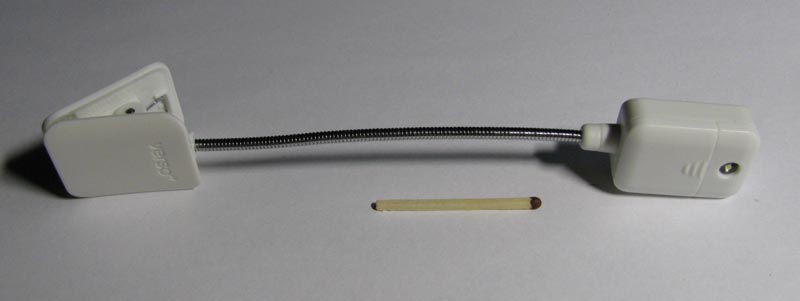
')
Head
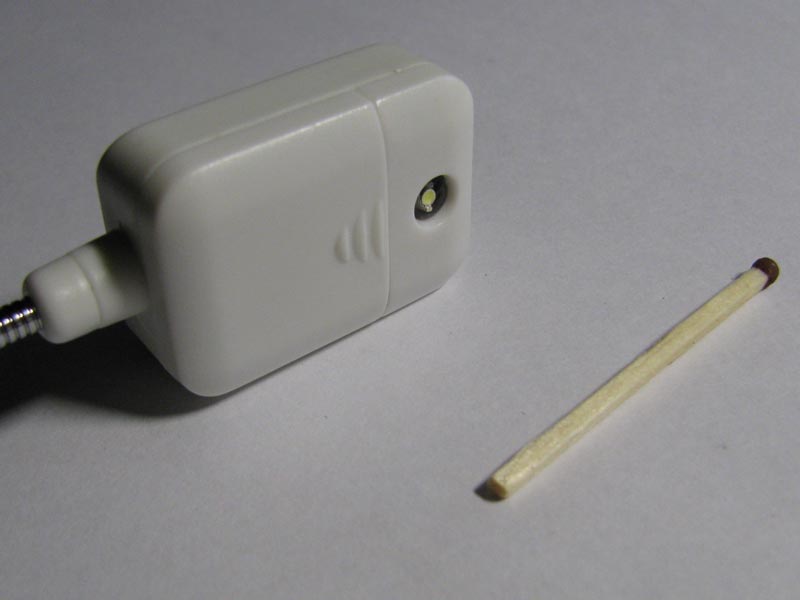
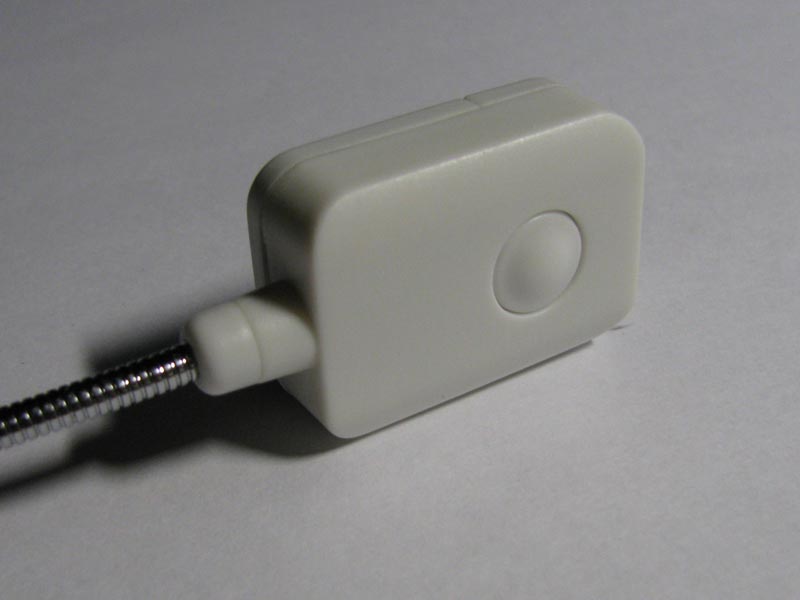
Nutrition

The clip clothespin is equipped with silicone slips
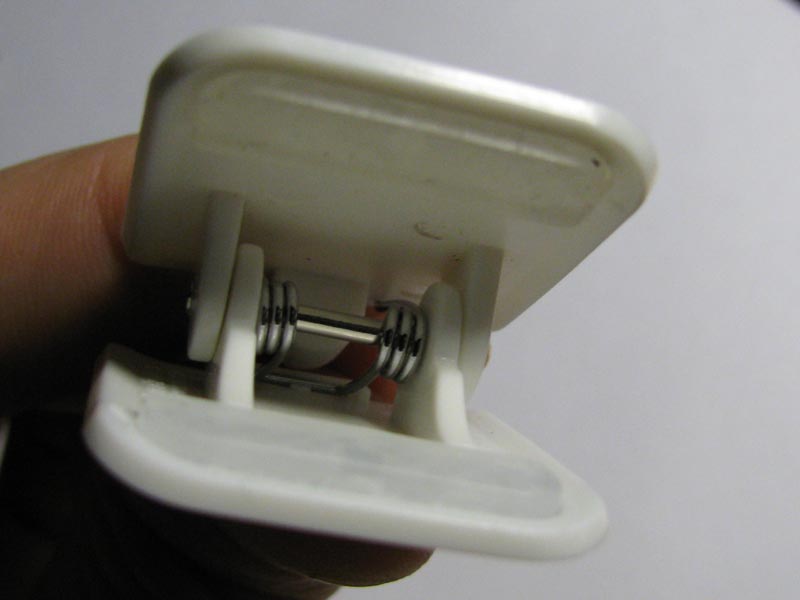
In business
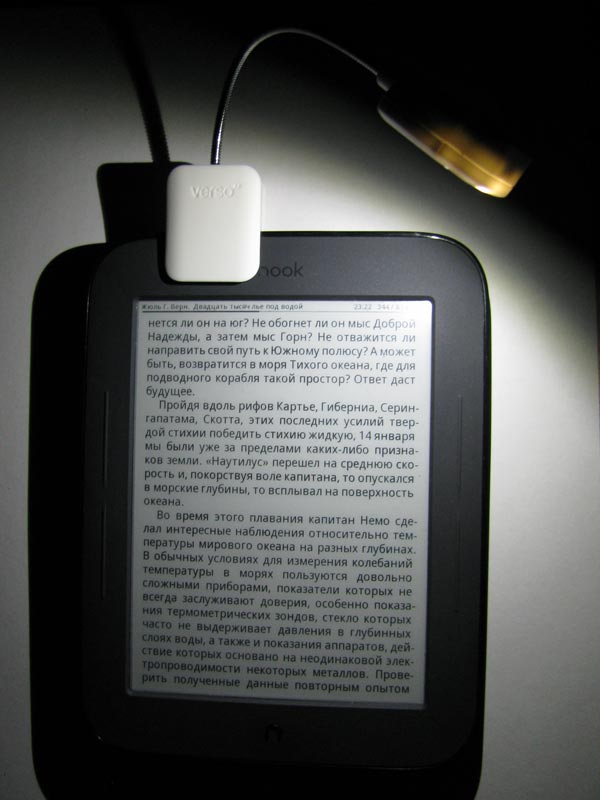
Sensations
So, our experimental one is powered by two CR2032 batteries. After pulling out the protective gasket between the batteries, the flashlight was able to turn on. In bright sunlight it seemed somehow not thick, but it was worth looking in the dark to understand that the backlight is very bright, has a good spectrum without blue (even amazing!). But why such brightness? Everything fell into place after measuring the current consumption. 60mA! Awesome load on batteries! With a capacity of 250 mAh, such a load will drop the batteries in about three hours (approx. The nominal capacity of the batteries is measured at low current, and with a large capacity, the calculated capacity cannot be reached - the battery dies much faster)!
Autopsy
Of course, I climbed inside to study the contents. As expected, the circuit is quite simple - a button, a resistor, an LED and a black patch on the board that controls the power on of the button. The LED was immediately connected to the laboratory power supply and measured by voltage on different currents. In my opinion, 20mA would be enough. After a brief calculation and measurement of the resistance of the standard resistor (38 Ohm), it was found that it would be nice to add another 100 Ohm in series. No sooner said than done. Satisfied with my “golden” hands, I read a book for half a night, brightness at 20mA turned out to be enough. And then there would be an end to the fairy tale, but one question did not give me peace.
As the battery voltage drops, so does the brightness.
And this oh, how unpleasant. This can and not to notice, but the fact is terribly annoying - half the time will have to suffer with weakening lighting, wanting to finish the batteries to the end. Damn, this is not our method! I climbed into the jungle of the Internet to look for something suitable, my hands itched to take a soldering iron! And, it seems, here it is - a 10mA LED driver , a format close to SMD, stick a couple of pieces in parallel, and you're done! But a careful study of the manual showed that when it falls on less than three to four volts, the current begins to be limited. Sailed ... What's next? Pulse Step-Down Converter? Well, but will not fit into the case - the place is very small. Only the linear stabilizer remains. In terms of energy saving, not so good, but we will have a constant brightness until the batteries are completely discharged, which is not bad. It did not take long to google, here it is - LP2980 . Excellent chips, if the current consumption is not more than 50mA, with an ultra-low voltage drop - not more than 120mV. Yeah, not KREN5! Yes, and a little more compact. In this device, the modification with a stabilization voltage of 3.3V was the best suited. At this voltage, the diode consumes exactly 20mA. What you need, even the resistor is not needed! From the strapping only need filtering capacitor at the output. Due to the small free volume of the electrolyte is not suitable - need tantalum. I put 10 uF. It is not easy to solder such babies by mounted installation, but I managed! Here is what happened:
Tantalum capacitor on the "snot"
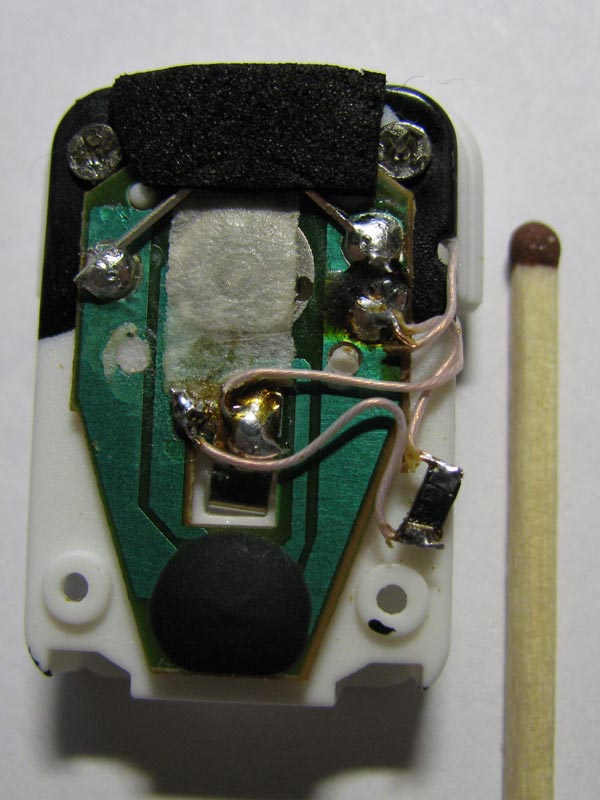
Stabilizer Chip
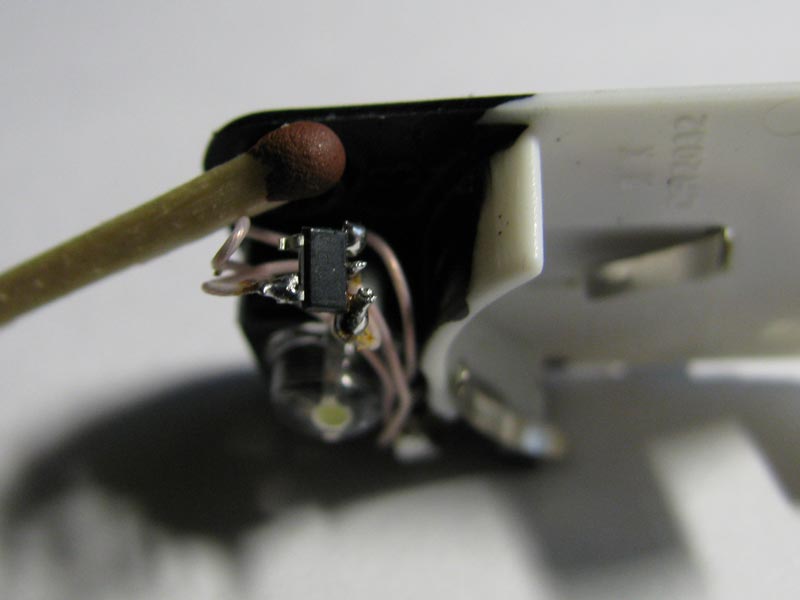
What we got
Estimated 12 and a half hours of work with a constant, not decreasing brightness. Yes, here I directly divided the capacitance by the current consumption, but this is a matter of thoroughly draining the batteries, the brightness does not drop until the voltage drops below 3.4 volts! And as it fell, you can change the batteries without pity - they are completely dead!
Power choice
Most of the luminaires disappeared because of the power supply - even with batteries of a mizinchik format (AAA), the e-book would have turned out to be a weighty backpack - as a rule, three little fingers are put in the backlight. Flashlights with “tablet” batteries did not seem like a good idea due to the small capacity and quite biting price. But there were a couple of models with nutrition, which seemed to me the best - lithium overgrown tablets CR2032. They have a good supply of energy - 0.75 W * h with a weight of 3 grams, and have very modest dimensions and weight compared to AAA - 1.1 W * h, weight 11.5 g. I will mention that I considered quite average CR2032 and good alkaline
AAA batteries, very expensive now. By the way, the CR2032 elements are not so expensive, I took two packs of 5 pieces for only 60 rubles per pack. Most baryg sell only one piece for the price of packaging, so I recommend looking for where it is cheaper and stocking up for the future.
The choice of form factor
After I decided on nutrition, it was time to choose a model. In Moscow, I managed to find only two - Pocketbook Mini Book Light and the hero of the review, Hama 54308. The choice fell on the latter, due to the flexible leg and great opportunities for adjusting the lighting. In addition, as I did not look at the photos of the Pocketbook's backlight, I didn’t understand how to mount it - but apparently, it’s a common clip, which is not a fact that I can be fixed on my Nook ST.
A photo
Full length

')
Head


Nutrition

The clip clothespin is equipped with silicone slips

In business

Sensations
So, our experimental one is powered by two CR2032 batteries. After pulling out the protective gasket between the batteries, the flashlight was able to turn on. In bright sunlight it seemed somehow not thick, but it was worth looking in the dark to understand that the backlight is very bright, has a good spectrum without blue (even amazing!). But why such brightness? Everything fell into place after measuring the current consumption. 60mA! Awesome load on batteries! With a capacity of 250 mAh, such a load will drop the batteries in about three hours (approx. The nominal capacity of the batteries is measured at low current, and with a large capacity, the calculated capacity cannot be reached - the battery dies much faster)!
Autopsy
Of course, I climbed inside to study the contents. As expected, the circuit is quite simple - a button, a resistor, an LED and a black patch on the board that controls the power on of the button. The LED was immediately connected to the laboratory power supply and measured by voltage on different currents. In my opinion, 20mA would be enough. After a brief calculation and measurement of the resistance of the standard resistor (38 Ohm), it was found that it would be nice to add another 100 Ohm in series. No sooner said than done. Satisfied with my “golden” hands, I read a book for half a night, brightness at 20mA turned out to be enough. And then there would be an end to the fairy tale, but one question did not give me peace.
As the battery voltage drops, so does the brightness.
And this oh, how unpleasant. This can and not to notice, but the fact is terribly annoying - half the time will have to suffer with weakening lighting, wanting to finish the batteries to the end. Damn, this is not our method! I climbed into the jungle of the Internet to look for something suitable, my hands itched to take a soldering iron! And, it seems, here it is - a 10mA LED driver , a format close to SMD, stick a couple of pieces in parallel, and you're done! But a careful study of the manual showed that when it falls on less than three to four volts, the current begins to be limited. Sailed ... What's next? Pulse Step-Down Converter? Well, but will not fit into the case - the place is very small. Only the linear stabilizer remains. In terms of energy saving, not so good, but we will have a constant brightness until the batteries are completely discharged, which is not bad. It did not take long to google, here it is - LP2980 . Excellent chips, if the current consumption is not more than 50mA, with an ultra-low voltage drop - not more than 120mV. Yeah, not KREN5! Yes, and a little more compact. In this device, the modification with a stabilization voltage of 3.3V was the best suited. At this voltage, the diode consumes exactly 20mA. What you need, even the resistor is not needed! From the strapping only need filtering capacitor at the output. Due to the small free volume of the electrolyte is not suitable - need tantalum. I put 10 uF. It is not easy to solder such babies by mounted installation, but I managed! Here is what happened:
Tantalum capacitor on the "snot"

Stabilizer Chip

What we got
Estimated 12 and a half hours of work with a constant, not decreasing brightness. Yes, here I directly divided the capacitance by the current consumption, but this is a matter of thoroughly draining the batteries, the brightness does not drop until the voltage drops below 3.4 volts! And as it fell, you can change the batteries without pity - they are completely dead!
Source: https://habr.com/ru/post/149830/
All Articles